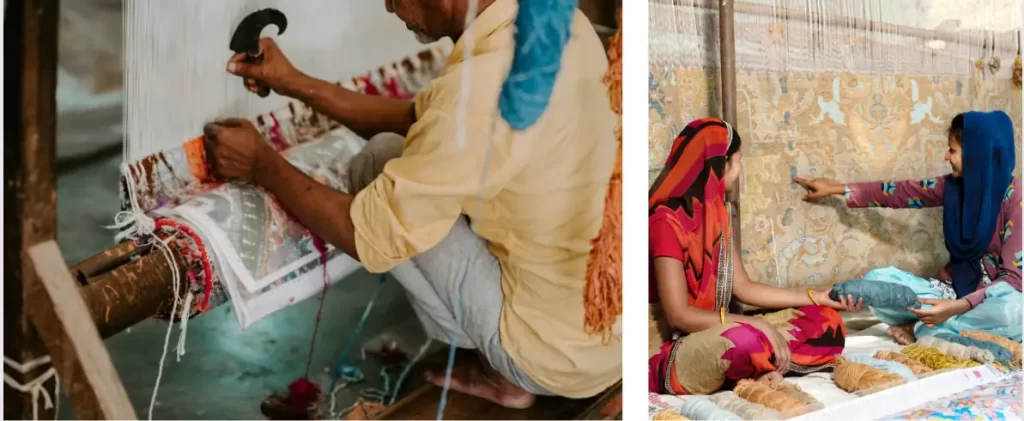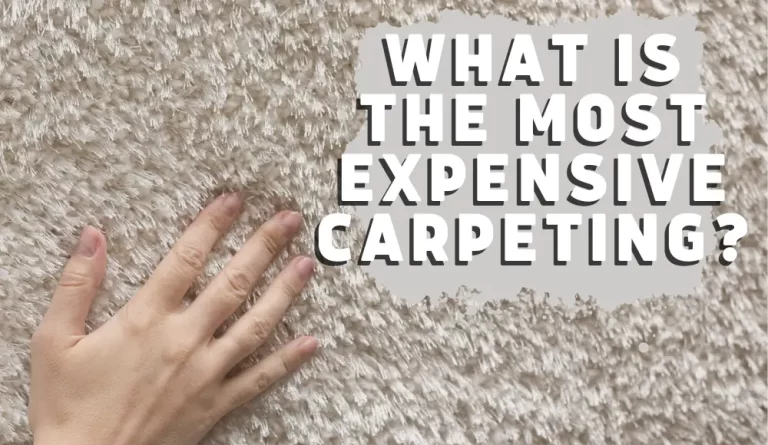When it comes to home flooring, carpeting is one of the most popular options for its soft feel and aesthetic appeal. However, not all carpeting is created equal. High-end or expensive carpeting is the epitome of luxury flooring, and as the saying goes, you get what you pay for. In this blog post, we will answer the million-dollar question: what is the most expensive type of carpeting today?
We will also explore the differences between expensive and affordable carpeting, how carpeting costs vary based on materials used, and offer tips for maintaining and caring for your expensive carpeting.
What Is Considered High-Quality Carpeting?
High-quality carpeting is a top-of-the-line option that’s often used in high-end homes, luxury hotels, and other exclusive locations. It is made from the finest materials and crafted with care to ensure its durability, texture, and appearance.

High-quality carpeting is typically more expensive than regular carpeting because of the premium materials and superior craftsmanship used in its construction.
How Does the Cost of Carpeting Vary Based on the Materials Used?
The cost of carpeting can vary significantly based on the materials used in its construction. Some of the most expensive materials used for carpeting include silk, wool, and specialty fibers such as alpaca and cashmere.
Synthetic materials such as nylon and polyester are less expensive but still, provide a luxurious feel and appearance.
Additionally, the quality of the materials used in carpeting affects its cost. For example, hand-woven or hand-tufted carpets are often more expensive than machine-made carpets because of the labor-intensive process involved in their creation.

Which Fibers Are the Most Expensive for Carpeting?
As mentioned earlier, silk, wool, alpaca, and cashmere are among the most expensive fibers used for carpeting. These materials are known for their durability, softness, and luxurious feel. Silk, in particular, is highly sought after for its sheen and luster, making it a popular choice for high-end carpeting.
However, there are other materials such as rare animal fibers, like qiviut or vicuna, which can be even more expensive than cashmere or silk. 0.35 oz of row vicuna fiber can cost about $70.
What Are the Most Expensive Carpeting Brands in the Market?
Who makes the most expensive carpet on the market?
There are several high-end carpeting brands, including:
- Karastan: Karastan is a luxury carpet brand that has been in the industry for over 90 years. They are known for their high-quality wool carpets, which are made with natural fibers and feature intricate patterns and designs. Karastan also offers other options, including nylon and SmartStrand silk carpets, which are known for their stain resistance.
- Couristan
- Stark: Stark is a luxury carpet brand that specializes in high-end wool and silk carpets. They offer a range of unique and stylish designs, including custom designs, and their carpets are handcrafted by skilled artisans. While Stark carpets come at a premium price, they are known for their quality and durability.
- Tufenkian
- The Rug Company
- Edward Fields
These brands are known for their premium materials, superior craftsmanship, and attention to detail, making them popular choices for luxury homes and commercial spaces.
What Are Some Alternatives to Expensive Carpeting That Still Offer a Luxury Look and Feel?
If you’re looking for a luxury look and feel without the high price tag, there are several alternatives to expensive carpeting. One option is to choose a synthetic carpet that mimics the look and feel of natural fibers, such as nylon or polyester. Another option is to choose a lower-priced natural fiber, such as jute or sisal, which still provides a sophisticated, high-end look.
How Do Factors Such as Size, Thickness, and Style Affect the Cost of Carpeting?
Several factors can affect the cost of carpeting, including the size of the room, the thickness of the carpeting, and the style of the carpeting.
The size of the room is one of the most obvious factors that can affect the cost of carpeting. Larger rooms will require more carpeting, which will inevitably increase the overall cost of the installation. Additionally, larger rooms may require more complex installation techniques, which can also increase the cost.
Another factor that can affect the cost of carpeting is the thickness of the carpeting. Thicker carpeting is generally considered to be of higher quality, as it offers better cushioning and can help absorb sound. However, thicker carpeting is also typically more expensive than thinner carpeting, as it requires more material to produce.
Finally, the style of the carpeting can also affect the cost. More intricate patterns or designs may require more time and effort to produce, which can drive up the cost of the carpeting.
Additionally, certain styles of carpeting may require specialized installation techniques, which can also increase the cost.
Which Fibers Are the Most Expensive for Carpeting?
When it comes to expensive carpeting, the fibers used to create the carpeting can play a significant role in the overall cost. Some of the most expensive fibers used in carpeting include wool, silk, and mohair.

Wool is considered to be one of the most luxurious and expensive fibers for carpeting, as it is soft, durable, and naturally stain-resistant. However, wool carpeting is also more expensive than other types of carpeting, as it requires more time and effort to produce.
Silk is another high-end fiber that is sometimes used in carpeting. Silk is incredibly soft and lustrous, but it is also very delicate and can be easily damaged. As a result, silk carpeting is typically reserved for low-traffic areas or used as decorative rugs rather than as wall-to-wall carpeting.
Mohair is a relatively uncommon fiber for carpeting, but it is sometimes used in high-end installations. Mohair is known for its durability and resistance to staining, and it also has a unique sheen that can add a touch of luxury to any room.
What Are the Differences Between Expensive and Affordable Carpeting?
The differences between expensive and affordable carpeting can vary depending on the specific materials used, as well as the manufacturing and installation processes. However, some general differences between the two include:
- Quality: Expensive carpeting is generally of higher quality than affordable carpeting. This means that it is often more durable, more stain-resistant, and more comfortable to walk on.
- Materials: Expensive carpeting is typically made from high-end materials such as wool, silk, or mohair, whereas affordable carpeting may be made from synthetic materials like nylon or polyester.
- Manufacturing: The manufacturing process for expensive carpeting is often more time-consuming and labor-intensive than the process for affordable carpeting. This can include techniques like hand-tufting or hand-knotting, which can increase the cost of carpeting.
- Installation: Finally, the installation process for expensive carpeting may be more complex and require specialized skills or tools. This can drive up the cost of installation, even if the carpeting itself is not significantly more expensive than affordable options.
What are some tips for maintaining and caring for expensive carpeting to ensure its longevity and appearance?
Maintaining expensive carpeting is important to ensure its longevity and appearance. Here are some tips to help you care for your high-end carpeting:
- Vacuum regularly: Vacuuming your carpet at least once a week helps remove dirt and debris that can cause wear and tear on the carpet fibers.
- Clean up spills immediately: Spills should be cleaned up immediately to prevent staining. Use a clean cloth to blot the spill, and avoid rubbing the carpet, which can spread the stain.
- Use professional cleaning services: Professional cleaning services can help deep clean your carpets and remove dirt and stains that regular vacuuming can’t reach.
- Use carpet padding: Carpet padding can help absorb impact and prevent wear and tear on the carpet fibers. It can also provide extra cushioning and insulation.
- Rotate furniture: Heavy furniture can leave dents in the carpet fibers over time. Rotating furniture periodically can help prevent these dents and keep the carpet looking even.
FAQs about Expensive Carpeting
What are the types of carpeting?
There are various types of carpeting available in the market, including Berber, Frieze, Plush, Saxony, Textured, and Cut and Loop. Each type has its unique characteristics and style, ranging from a luxurious plush feel to a more textured and durable option.
Is wall-to-wall carpeting expensive?
Wall-to-wall carpeting can be expensive depending on the quality and material used. It requires more carpeting than a smaller area rug, which increases the overall cost. Additionally, the installation of wall-to-wall carpeting can also add to the expense, as it requires precise measurements and professional installation.
Conclusion:
Expensive carpeting can provide a luxurious look and feel to any room, but it’s important to choose the right materials and brands to ensure quality and durability. When considering expensive carpeting, it’s important to weigh the costs and benefits, as well as consider alternative options that still provide a luxury look and feel.
By understanding the factors that affect the cost of carpeting and taking steps to maintain and care for your carpeting properly, you can ensure its longevity and keep it looking beautiful for years to come.

